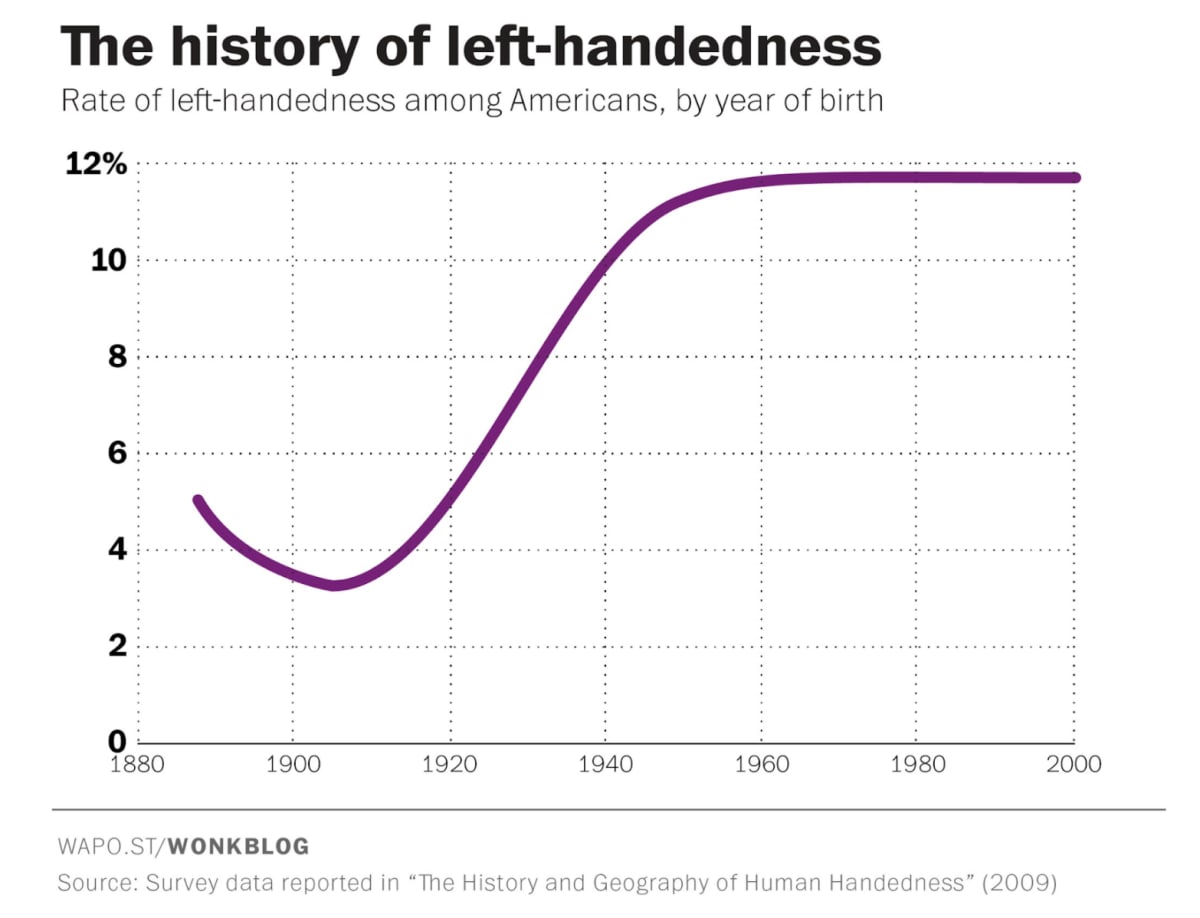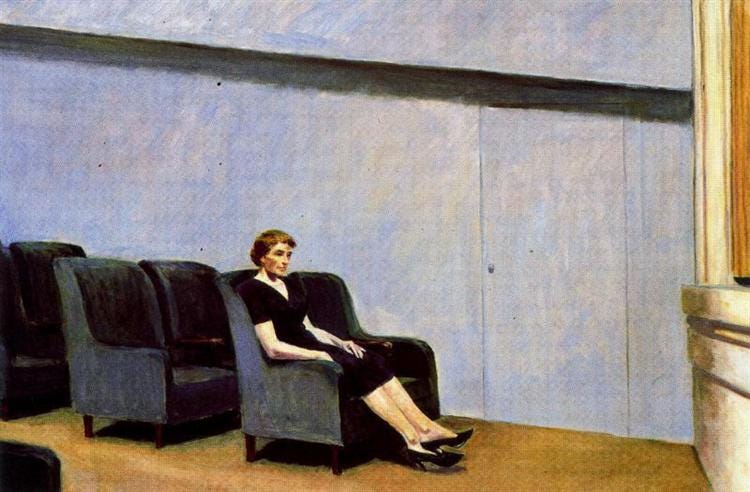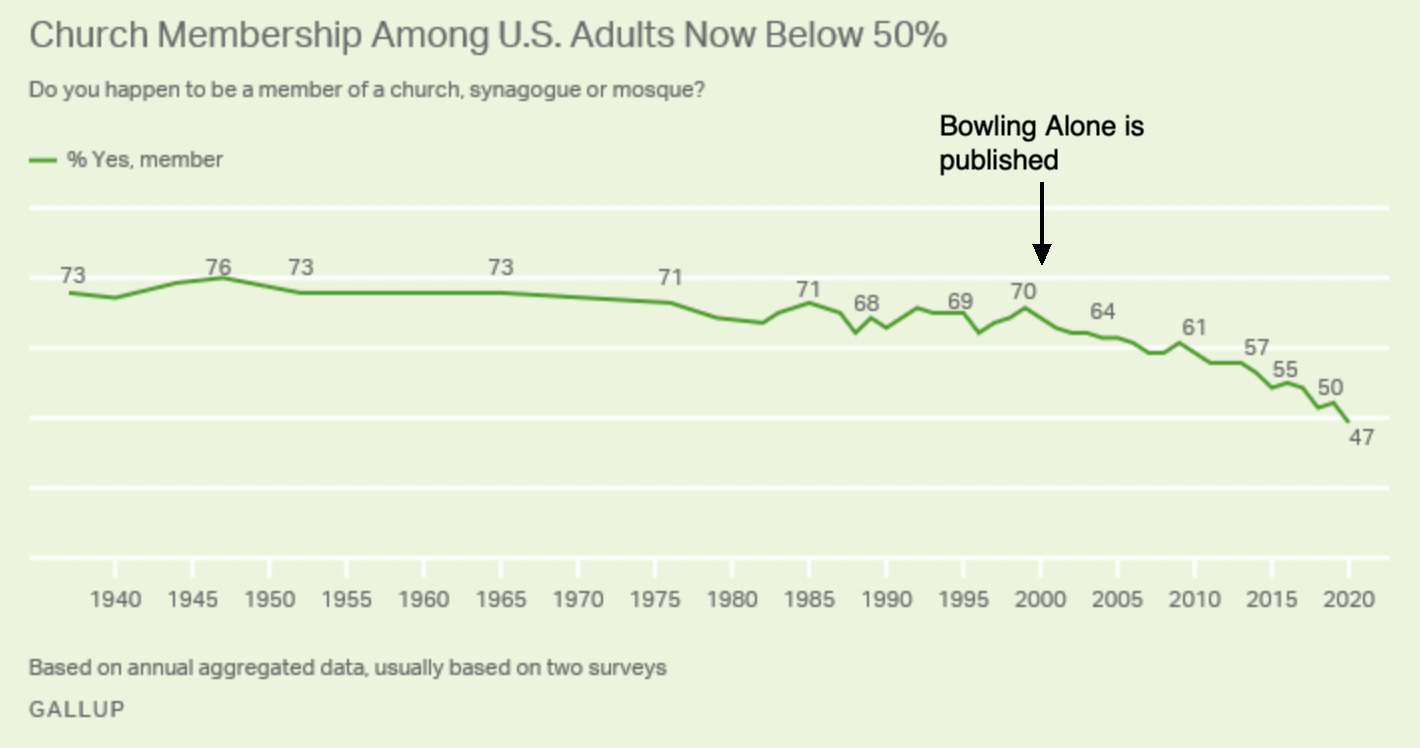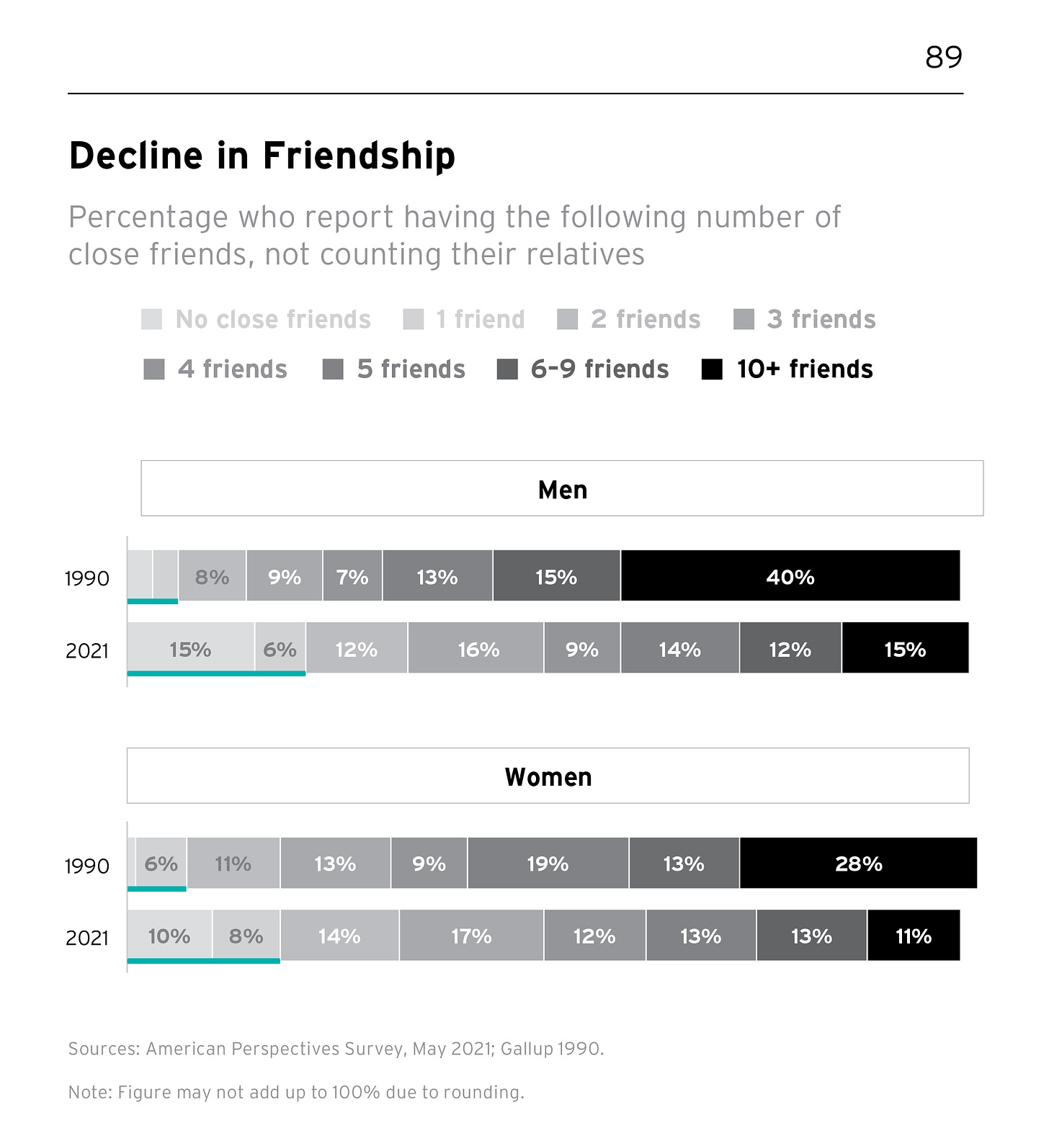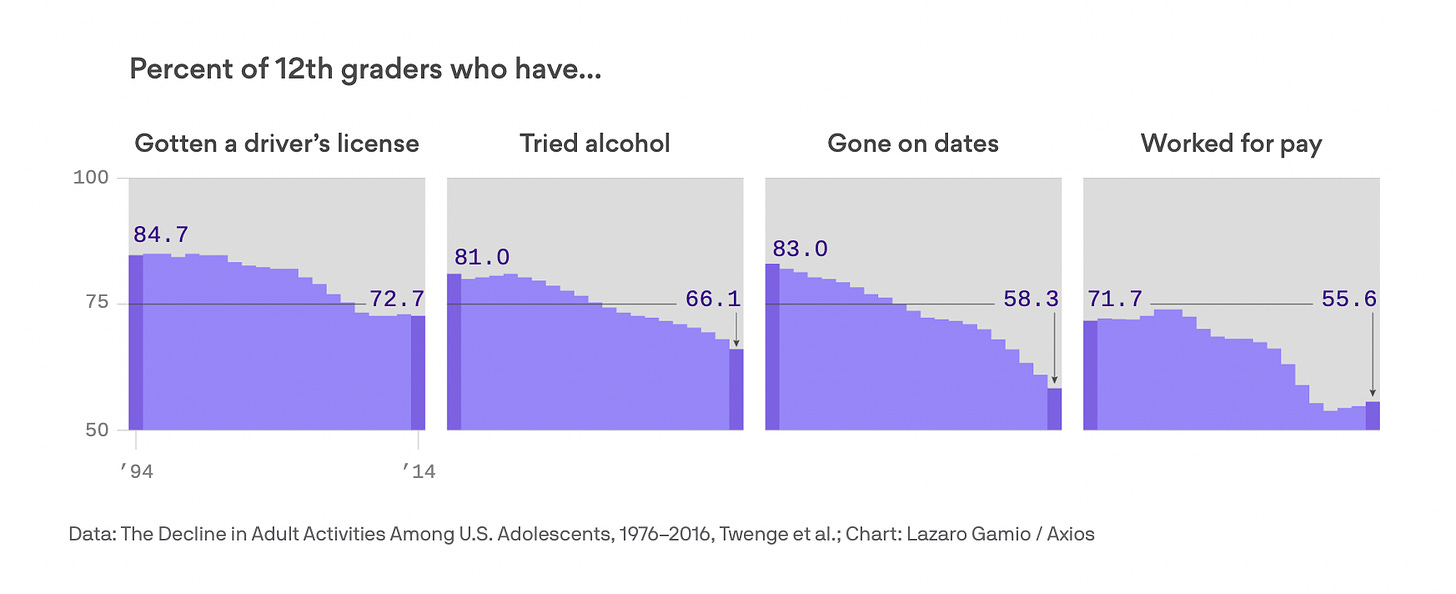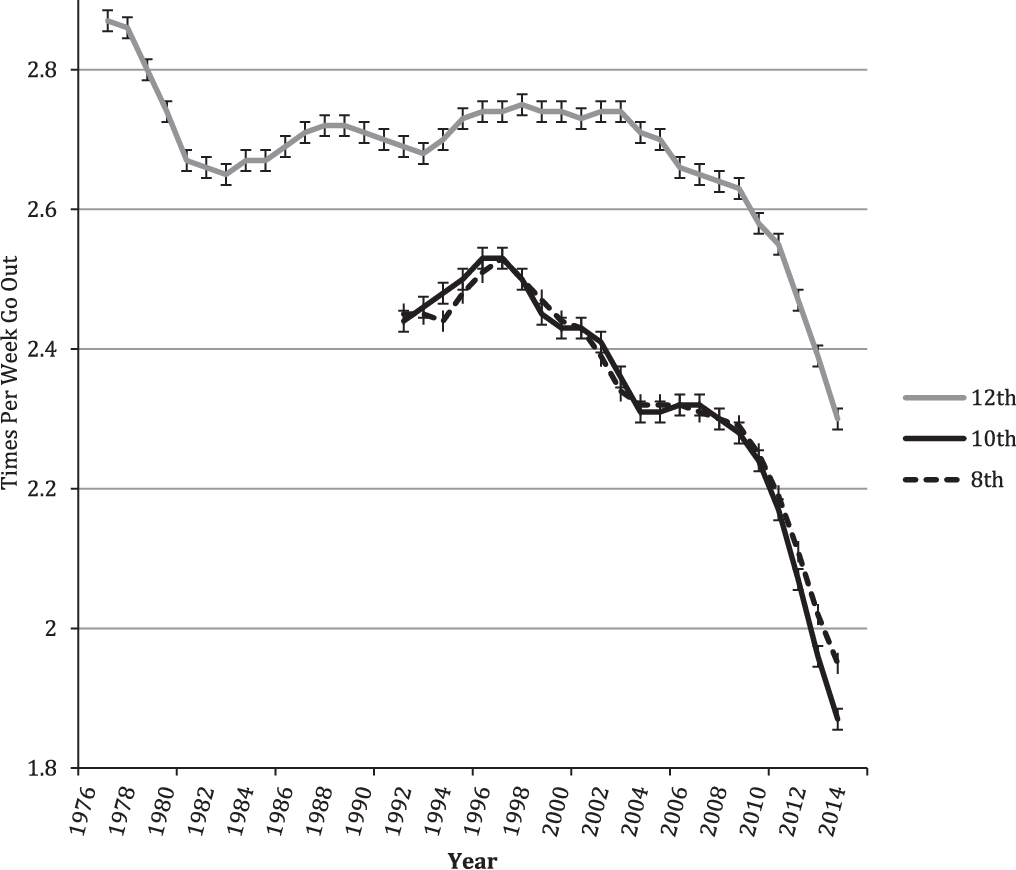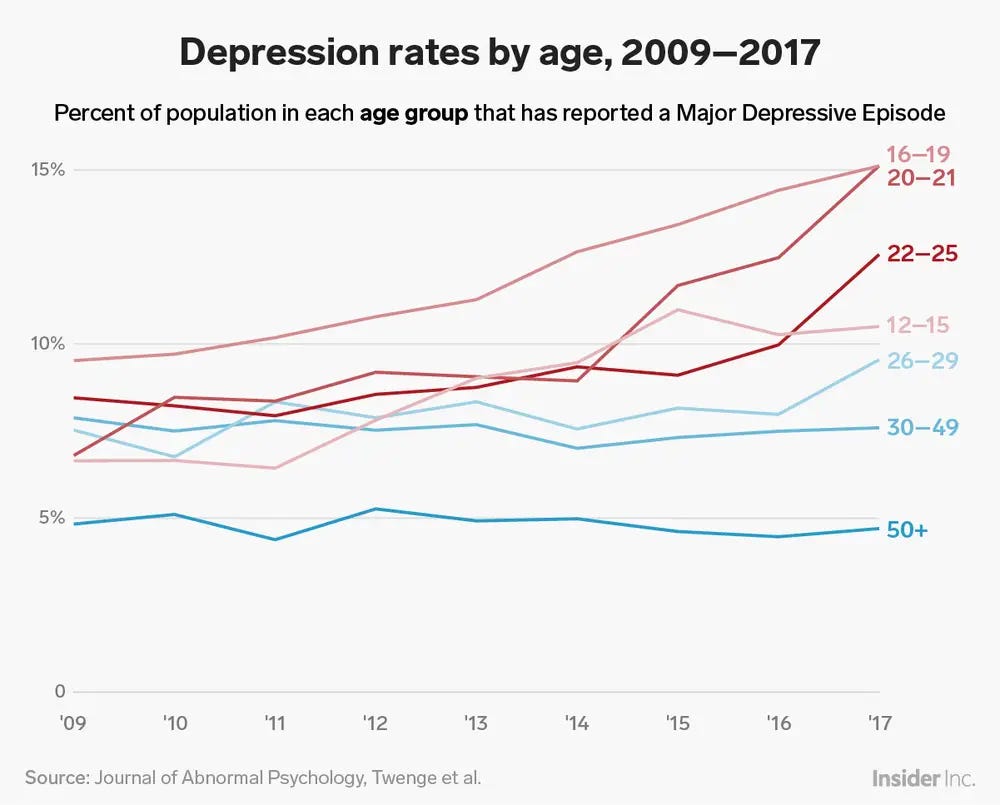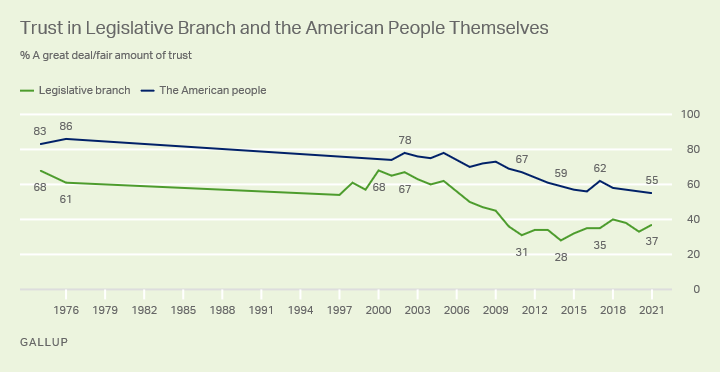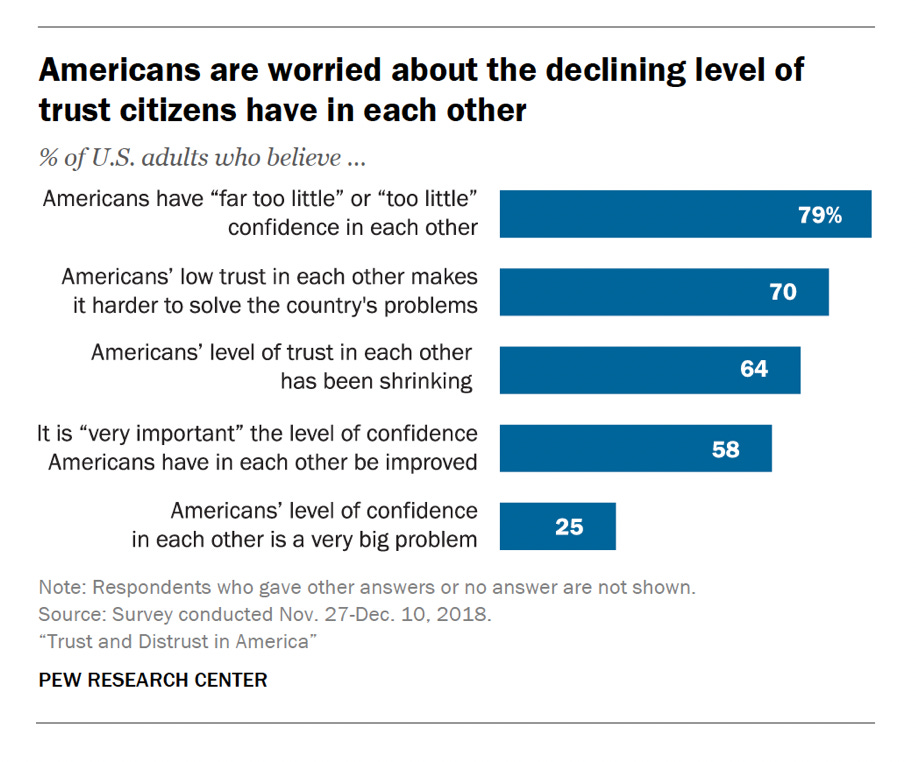The Social Recession: By the Numbers
19[anonymous]
3antonomon
14mako yass
9CronoDAS
15Ben
4Said Achmiz
2MSRayne
1DarkAcreJack
9Teerth Aloke
5antonomon
3Teerth Aloke
2antonomon
4Aloekine
6James Camacho
2antonomon
6Ciprian Elliu Ivanof
5mako yass
2Raemon
1Guillaume Charrier
1Ppxl
0PoignardAzur
6MSRayne
3Dzoldzaya
2MSRayne
2Foyle
1PoignardAzur
11MSRayne
2Benjy Forstadt
2PoignardAzur
New Comment
The epistemics here are fantastic and if I could I'd make it a featured article. Definitely critical for any world modelling.
However, the trust section heavily features declining trust in institutions and public opinion as examples. I don't think those are good examples, since it could indicate that people are becoming more aware of institutional realities and election dynamics, such as Watergate, the War on Terror, or more people noticing things that seem "off" about the idea of democracy. Historically, large proportions of people became pessimistic about institutions in China and the Soviet Union after periods of economic hardship and political turmoil, decades before the first social media company became large enough to start seeing IRL communication as a competitor.
Which trust metrics would you instead use? The Gallup numbers are an aggregate of trust across many spheres by the way, and include areas as distant from each other as healthcare to church to Congress. While a crisis may certainly cause distrust in the state, the decline of trust has affected virtually every sphere of social life which points toward a more systematic chipping away across the board. Because of this, I would say the catalyst is a different kind of (online) sociability altogether that is taking root today.
Entertainment (enjoyment, the authentic self) and socializing separated. People watched TV alone, and then people gamed alone and then people scrolled social media together but not really and they were still basically alone.
I think it's fairly likely that the pattern will be interrupted with VR. The reasons are dumb. VR headsets package in good microphones and spacialized audio makes talking in groups fun again. We'll start to see better team games, or just social venues where people mix and talk for its own sake. Then the social online world will be a lot more enticing.
People used to game together. These days, you can't even put a chat window in your online card game because you have to hire moderators to deal with people being assholes to each other and/or would-be child molesters, and that's a whole lot more expensive than just not letting players talk to each other. Unless you're World of Warcraft, it just doesn't pay.
Another data point on this theory. When I was a child "computer games" meant 5 overexcited children screaming and shoving one another off a sofa while at any one time 4 out of 5 of them were nominally playing on the nintendo (mario kart and party were particularly popular). This clearly shifted a lot, because around 2018 I remember returning a new halo game when I found out it couldn't do split-screen. (It honestly never occurred to me to check, a shooter without split screen just feels, awful).
To me, the new "bowling alone" is "FPS without split screen".
Meanwhile, split-screen seems to me to be such a patently horrible way to play an FPS that I can’t imagine anyone liking it (and I’ve been playing FPSes since FPSes existed).
Large language models may soon (if not already) make it much easier and cheaper to moderate such spaces, so maybe we'll see a resurgence of that?
The idea that placing a helmet over one's head that obscures visual and audio perception of the real world will somehow interrupt the separation of socialization assumes that digital socialization is a replacement for or at least some kind of remedy to not having IRL interactions. To me this seems an exacerbation of the problem, not an alleviation.
Seems to be the same in many other countries, actually. In East Asia, these trends are especially prevalent.
This unfortunately is also from more of a pre-social media period than I would hope for, but Putnam’s other book (really a collection of essays by people more knowledgable on specific countries) Democracies in Flux from 2002 (https://academic.oup.com/book/8126) looks at similar trends across 8 countries: Australia, France, Germany, Great Britain, Japan, Spain, Sweden, and the United States. To be clear, this is most focused on the aspects of social capital one would expect to be related to the functioning of democracy like trust and institutional memberships.
Their overall findings are that the declines seen in the US are less uniformly reflected elsewhere than I predicted prior to reading it, and that it’s also less clear than I predicted what relationship this has to functioning of democracy (again, this is most focused on measures of social capital most plausibly related to democracy). Overall, I recall coming away thinking imputing trends from the US onto other countries might paint an overly bleak picture of social capital trends, and that the causal link from declining social capital to effects on democracy was less certain than I previously thought.
That isn’t to say things are going wonderfully everywhere else, just that anchoring to the US may paint an overly bleak picture.
I don’t want to wholesale endorse this discussion of the book since it’s been a year or two since I read the original, but this seems like a reasonable summary I found for folks who are curious: https://www.beyondintractability.org/bksum/putnam-democracies.
I’d be curious to see any research folks have that take a comparative lens that are more recent, or that more specially focus on the social/emotional impacts more!
Have you considered that signaling could play a large part into this? A European friend of mine once said, "people in the US try to do everything in high school." Because, to get into a top undergraduate program, Americans have to signal very hard. Worse, a master's degree is quickly becoming the new high school diploma, due to signaling to employers.
When kids are spending their lives trying to signal stronger, it's a lot harder to balance it with friends. It used to be dating as an undergraduate made sense--people would actually get married during or out of college! Now, it makes less sense to date for a year or two and try to maintain a long-distance relationship as you split off into different PhD programs.
Maybe, that makes sense to me. As an offshoot of that (sort of), I would also say on the internet really produces so much FOMO - and a lot of people feel resentment over that, especially coupled with loneliness nowadays. Browsing social media just makes so many people feel worse.
So, people are signaling more and those "left out" feel worthless amid FOMO as if they are behind or 'not living their best life.'
I suspect some of this is tied into the increasing sense of interdependence and the reality that there are different trust systems that people use. Being bombarded with reminders that you are defendant on people who use very different trust systems is inherently anxiety producing and the increasing pace of information flow is certain to exacerbate that.
Another facet may be that big projects, while rarely economically efficient, may have a psychological grandeur that people crave. Note William James search for a "moral equivalent to war" in that the psychological yearning for achievement, sacrifice, and victory is inherently human and being awash in reminders of how others achieve and of how pampered one's one life is likely to sap any sense of achievement.
the psychological yearning for achievement, sacrifice, and victory
Yeah, how do I find a place in the social fabric and build enough of a sense of self-esteem to put myself out there if almost all work that I admire is done by a very small percentage of freakishly talented IP producers that I'm unlikely to ever be a part of? And even if I am going to be one of them, how do I survive the 25 years of hazing society puts me through before I make it there?
Curated. I've had a sense of some kind of massive societal change happening. I too read Bowling Alone a few years ago and remember being impressed by it's epistemic framing but disappointed that it was 2 decades old. Seeing more concrete data about that feels useful to me orienting to the world.
(I am, as always, interested in people digging into the details of the data and seeing whether it all checks out, whether some bits are misleading, etc)
Bizarly, for people whose tendencies were to the schizoid anyway and regardless of sociological changes - this might be midly comforting. Your plight will always seem somewhat more bearable when it is shared by many.
Also: the fact that people now move out later might be a kind of disguised compliment, or at least nod, to better quality parents-children relationships. While I was never particularly resourceful or independent, I couldn't wait to move out - but that was not necessarily for the right reasons.
Finally - one potentially interesting way of looking at the increasingly exacerbated partisanship / level of political division across the country might be as a sort of last ditch attempt to fight desocialization. When no community remains the "I really don't like liberals" and "I really don't like conservatives" groups of kindred spirits offer what might be the last credible alternative to it.
Atomization and loneliness is a direct outcome of modernity and urbanization. It’s the job of corporations is to fill niches for profit, including social niches. substituting your community for profit is the natural progression of capitalism. Social media is directly competing with your time otherwise spent with friends and family. Real Companionship directly competes with things like onlyfans and streamers. All transactions need to be commoditized. If you want to say hi to your friends you must do it through a corporation!
At the end of the line, we’ll all be technologically self sufficient, perfectly atomized, each living in our own universe (hence the multiverse).
Share of individuals under age 30 who report who report zero opposite sex sexual partners since they turned 30.
Wait, did that survey account for sexual orientation? Because if it didn't, it's essentially worthless.
Why? Roughly 97% of people are heterosexual. I don't see how sexual orientation could massively skew the results.
20% of Gen Z Americans seem to identify as LGBT, so increasing LGBT rates could explain a lot of the variance- especially for women (where there's less variance to explain and more LGBT). Correction: (But it does seem that the B (57%) is more common than the LGT (https://news.gallup.com/poll/389792/lgbt-identification-ticks-up.aspx), which might make it less explanatory - but there could be a reasonable proportion of bi young people avoiding hetero relationships).
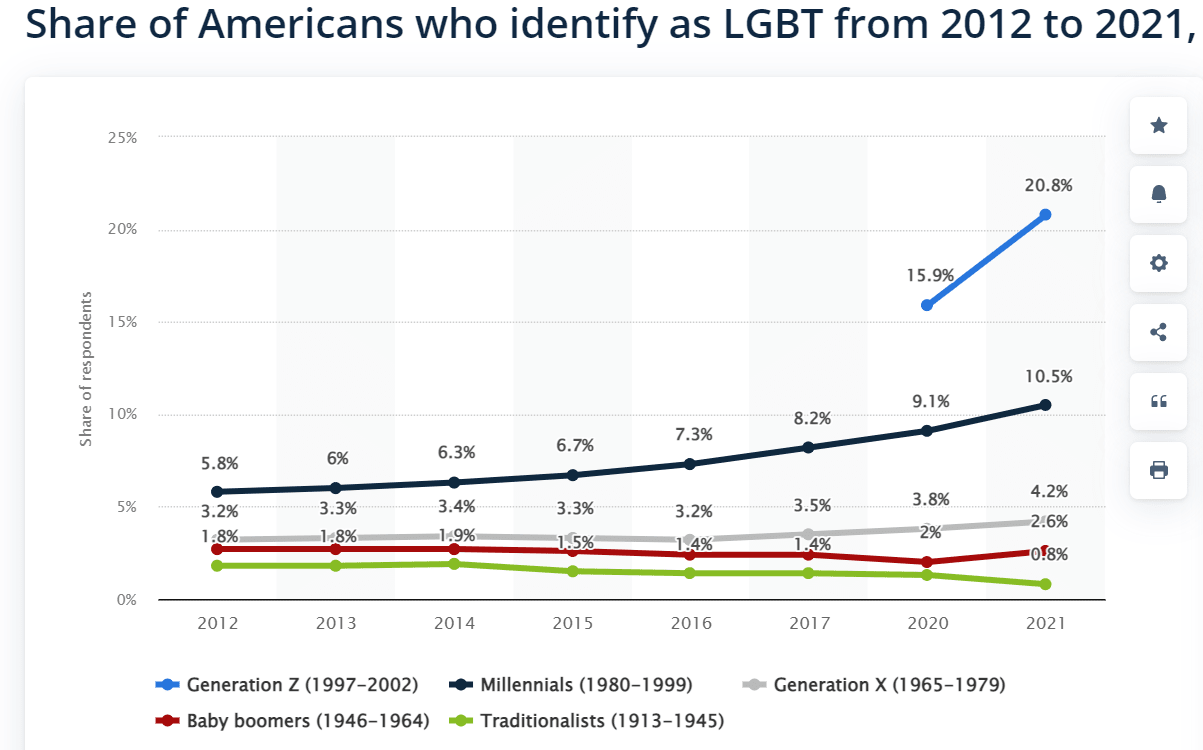
That is... kinda shocking to me, tbh. Why would it have increased that much? This has to be cultural influence.
Humans generally crave acceptance by peer groups and are highly influenceable, this is more true of women than men (higher trait agreeableness), likely for evolutionary reasons.
As media and academia shifted strongly towards messaging and positively representing LGBT over last 20-30 years, reinforced by social media with a degree of capture of algorithmic controls be people with strongly pro-LGBT views, they have likely pulled means beliefs and expressed behaviours beyond what would perhaps be innately normal in a more neutral non-proselytising environment absent the environmental pressures they impose.
International variance in levels of LGBT-ness in different cultures is high even amongst countries where social penalties are (probably?) low. The cultural promotion aspect is clearly powerful.
https://www.statista.com/statistics/1270143/lgbt-identification-worldwide-country/
The obvious explanation would be "because LGBT people are less pressured to present as heterosexual than they used to be".
I don't think it is plausible that there is such a high natural rate of non-cishet people in the human species. I think this is an example of "Born This Way" being bullshit and culture actually modifying people's sexual and gender identity during sensitive imprinting periods in childhood. (Before you call me a homophobe, I'm LGBT myself, and I am pretty sure it actually is partly because of childhood experiences.)
"LGBT-ness" is not one thing. It is a political/cultural category that lumps together several demographic categories. I continue to think gay men, at least, are probably (mostly?) born that way.
The Center for the Study of Partisanship and Ideology did a detailed report on the LGBT increase. Quote:
"When we look at homosexual behavior, we find that it has grown much less rapidly than LGBT identification. Men and women under 30 who reported a sexual partner in the last five years dropped from around 96% exclusively heterosexual in the 1990s to 92% exclusively heterosexual in 2021. Whereas in 2008 attitudes and behavior were similar, by 2021 LGBT identification was running at twice the rate of LGBT sexual behavior.
[...] high-point estimate of an 11-point increase in LGBT identity between 2008 and 2021 among Americans under 30. Of that, around 4 points can be explained by an increase in same-sex behavior. The majority of the increase in LGBT identity can be traced to how those who only engage in heterosexual behavior describe themselves"
FWIW, I don't think it's a homophobic viewpoint, but it seems like a somewhat bitter perspective, of the sort generally associated with, but not implying, homophobia. Anyway, it's tangential to the main point.
Re: social pressure: I was thinking of the "lefthandedness over time" graphs than got viral last year (of course the graphs could be false; the one fact-checker I found seems to think it's true):
The two obvious explanations are:
- Left-handed acceptance culture led to people living more childhood experiences that subtly influenced them in ways that made them turn out left-handed more often.
- People who got beat by their teacher when they wrote with their left hand learned to tough it out and use their right hand, and started to identify as right-handed. As teachers stopped beating kids, populations reverted to the baseline rate of left-handed people.
Occam's razor suggests the latter. People got strongly pressured into appearing right-handed, so they appeared right-handed.
If we accept the second explanation, then we accept that social pressure can account for about 8 points of people-identify-as-X-but-are-actually-Y. With that in mind, people going from 1.8% to 20% seems a bit surprising, but not completely outlandish.
Anyway, all of the above is still tangential to the main point. Even if we assume all of the difference is due to childhood imprinting, we still have rates of LGBT-ness going from 5.8% to 20.8% (depending on how you count). No matter where that change comes from, it's going to impact how much people have sex with opposite-sex people, and any study that doesn't account for that impact and reports a less-than-20% change in the rate-of-having-sex is, I believe, close to worthless.
